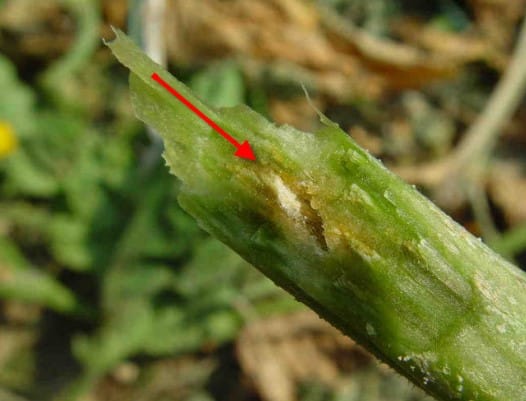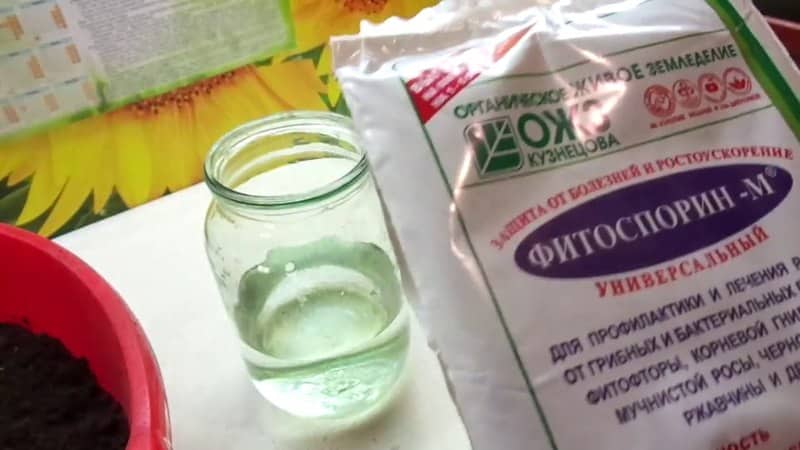Causes and methods of treatment of black plaque on cucumber leaves in a greenhouse
Cucumbers are one of the most beloved crops by gardeners. The achievements of modern selection make it possible to grow this wonderful vegetable not only in garden plots, but even on window sills and balconies. However, this is a southern plant that loves warmth and sun, so in northern latitudes it is often grown indoors.
Greenhouse cucumbers are susceptible to the same diseases, like all melons and melons. In this article we will talk about black plaque on the leaves of cucumbers in a greenhouse, the reasons for its development and ways to combat it.
Causes of black plaque
In a greenhouse, it is easy to create optimal conditions for growing cucumber crops. To get a good harvest, it is enough to observe the temperature regime, ventilate the room, monitor humidity and light.
However, even under such conditions, plants are susceptible to diseases. Their development is provoked by violation of agricultural technology standards, the use of small greenhouses and greenhouses, and the cultivation of crops that require different care conditions in one building.
Common problems that arise when growing cucumbers in a greenhouse include the appearance of a black coating on the leaves and fruits. There are a number of causes for the occurrence of the disease.

Black leaf mold
This is a disease caused by the development of a harmful fungus. It affects not only the leaves, but also the stems of the cucumber bush.
The development of the disease begins with the appearance of small light brown spots on the leaves, similar to burns. After some time, the spots merge into one whole, forming large blots of dead tissue.
First of all, the fungus attacks old leaves. If the infection is not fought, it spreads to the stems, petioles and greens, which dry out and become covered with a black coating.
The impetus for the development of the disease is a sharp change in day and night temperatures in a greenhouse or greenhouse. Injuries to cucumber bushes caused by blinding, pinching and pinching contribute to the development and spread of the fungus.
If the causative agent of the infection is not combated, it will spread to all crops nearby. The fungus is resistant to temperature changes and overwinters on plant debris, in soil, and on the structures of greenhouses and greenhouses. Seed material can also be a source of disease.
Sooty fungus
Sooty fungus (black fungus) is another fungal disease that affects greenhouse plantings. The infection causes the greatest harm to young vegetables.
The fungus overwinters in the soil, on plant debris. With the onset of warmth, it becomes more active and affects the crop. The disease is recognized by small black spots on leaves and fruits that resemble soot. If measures are not taken, the fungus affects the entire bush, covering the leaves, stems and fruits with a black coating.
The reason for the development of sooty fungus is pests, such as aphids and whiteflies. Parasites cover the tops with sweet secretions, on which the infection multiplies.
Leaf spot
Leaf spot is a common disease that affects not only cucumber, but also many other crops. The infection is caused by fungi (mycoses), bacteria (bacterioses) or viruses.Nematodes are another cause of leaf spots.
The variety of causative agents of the disease complicates the fight against it. Progressive spotting is most dangerous for young plants. The disease leads to impaired photosynthesis, drying and falling of leaves, depletion of the crop and its death.
Fusarium
This type of fungus infects the leaves and stems of cucumbers, leading to the withering of the greenery and vines of the plant, and subsequently to the complete death of the bush.
The pathogen penetrates the vegetable from the soil. Small roots are affected first, then larger ones. Through the roots, through the vessels, the fungus enters the vines and leaves. Gradually the stem becomes thinner and turns brown. Soon the entire bush withers and dies.
A frequent impetus for the development of the disease is excessive watering. It is not difficult to recognize fusarium: just look at the cross section of a cucumber stem (as in the photo). In a diseased plant, the core of the stem is brown.

Methods to combat black plaque
What to do if a problem is discovered? When the first dark spots appear, measures to combat the disease are immediately taken. If the cause of the infection is not eliminated, it will spread first to the entire bush and then to neighboring plants.
First of all, all affected leaves and vines of the crop are cut off and destroyed. After this, the bushes are treated with special means to destroy the causative agent of the disease.
Chemicals
Chemicals have shown the greatest effectiveness in combating fungal diseases. When the first signs of damage appear, cucumber bushes are sprayed with a 0.7–1.0% solution of Bordeaux mixture or a 0.5% suspension of copper oxychloride. The treatment is repeated after 8–10 days.
The fungicide "Topaz" has proven itself well. This is a chemical agent that has a systemic effect.The main substance, penconazole, suppresses the activity of phytopathogenic fungi during the reproduction period. Spraying is carried out in accordance with the instructions. The drug is used before and after flowering.
Fungal diseases can develop resistance and immunity to fungicides. Therefore, the chemicals used alternate.
Biological methods
If you are wary of using chemicals on your property, there is a good alternative: biofungicides. They are used to treat plants and prevent diseases. The products are environmentally friendly, harmless to humans, animals, birds and insects.
Biofungicides include drugs such as Fitosporin, Pseudobacterin, Gamair.
Fitosporin
Fitosporin is a well-known and widely used elicitor that enhances plants’ own defense and immunity. The drug is available in the form of paste, powder, solution.
 The paste is effective for processing soil and humus, and is used to protect root crops when storing them for winter storage. Powder and solution are used for plant treatment and prevention.
The paste is effective for processing soil and humus, and is used to protect root crops when storing them for winter storage. Powder and solution are used for plant treatment and prevention.
The product becomes active when the temperature rises to +7 °C. It is advisable to use the drug for cultivating the land starting in early spring.
Pseudobacterin
Pseudobacterin is a biofungicide used to combat fungal and bacterial diseases. It has a pronounced growth-stimulating effect without reducing the quality of vegetables and fruits.
The product is compatible with other pesticides and agrochemicals.
Gamair
Gamair is a microbiological fungicide that is effective against a number of fungal diseases, such as root rot, powdery mildew, downy mildew, black and gray mold, rust.Gamair is available in the form of tablets, soluble in water. It is used for both treatment and preventive purposes.
Traditional methods
When the first signs of black plaque appear on the leaves, it is advisable to start treatment with safe traditional methods.
Among the variety of similar methods of combating fungal diseases, the replacement method is considered the most effective. Its essence lies in the displacement of the fungus by more active beneficial microorganisms. Such useful substitutes are found in natural dairy products - milk and whey.
To prepare the solution, the product is mixed with water in a ratio of 1:10 and the cucumber bushes are sprayed with a spray bottle. Beneficial microorganisms destroy harmful fungus on the leaves and vines of the crop, thereby stopping the development of the disease. Not only sick plants are sprayed, but also all healthy plants in the greenhouse.
In the initial stages of infection, spraying with infusions of herbs (nettle, tansy, wormwood) helps.
Important! Spraying is carried out early in the morning or in the evening. Sunlight on wet leaves causes burns.
It is effective to treat bushes with a mixture of ash and laundry soap diluted in water, as well as spraying with a solution of soda and soap.
Preventive measures
Any disease, including that of vegetables, is easier to prevent than to treat. Therefore, when growing plants, special attention is paid to disease prevention measures.
Important! Excessive thickening of plantings is one of the main causes of the occurrence and development of fungal diseases.
Prevention measures include:
- Treatment of seed material and soil before planting with a solution of biofungicides.If in the previous season there were a lot of fungal diseases on the site, then the soil is treated 3-4 times.
- Compliance with agrotechnical rules for growing vegetable crops. When planting seedlings, maintain the required distance between the bushes. Weak, diseased, damaged leaves and shoots are removed in a timely manner.
- Autumn cleaning of the garden plot from fallen leaves and plant debris, which create favorable soil for the development of fungus and mold.
- Timely application of not only nitrogen, but also phosphorus-potassium fertilizers. Excess nitrogenous fertilizers in the soil contributes to the occurrence of diseases.
Read also:
What are red cucumbers (Tladiantha dubious), why are they good?
How to pinch cucumbers correctly - when and why it is necessary.
Recommendations from experienced gardeners

In itself, black plaque on cucumber leaves does not cause much harm to the crop. However, its appearance indicates infection of the plantings or improper growing conditions.
Fungal diseases arise and actively spread on weakened plants infected with insect pests. Pests such as aphids, thrips, and whiteflies leave sticky, sugary secretions on which the fungus grows.
Advice! At the first sign of pests, take action to eliminate them.
The fungus loves high soil and air humidity. Therefore, when growing cucumbers in a greenhouse, it is important to maintain optimal air humidity in the room and prevent the soil from becoming waterlogged.
Densified plantings and excessive growth of greenery impede the flow of air to the bushes and contribute to the occurrence and spread of fungal diseases.
Important! Adding potassium fertilizers to the soil in spring and autumn protects plants from infections.
Conclusion
Black plaque on cucumber leaves interferes with the natural process of photosynthesis and, consequently, the development of the plant and the growth of fruits. The reason for the appearance of plaque lies in fungal diseases. Controlling pests such as aphids, whiteflies, as well as controlling soil and air moisture will prevent the development of infections and black plaque on leaves and stems.